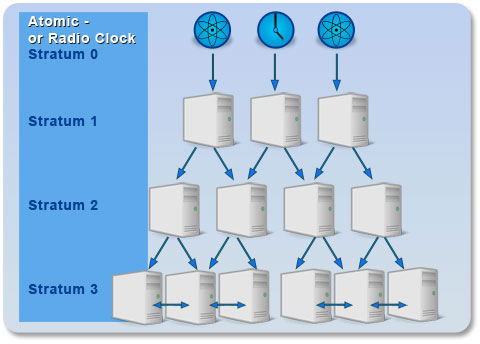NTP: The Network Time Protocol
NTP is a common method for synchronization of hardware clocks in local and global networks. The basic concept, version 1 [Mills88], was published in 1988 as RFC (Request For Comments). Experiences made from the practical use in Internet was followed by version 2 [Mills89]. The software package NTP is an implementation of the actual version 3 [Mills90], based on the specification RFC- 1305 from1990.

NTP's way of operation is basically different from that of most other protocols. NTP does not synchronise all connected clocks, it forms a hierarchy of timeservers and clients. A level in this hierarchy is called a stratum, and Stratum-1 is the highest level.
Timeservers of this level synchronise themselves by a reference time source, such as a radio controlled clock, GPS-receiver or modem time distribution. Stratum-1-Servers distribute their time to several clients in the network which are called Stratum-2.
A high precision synchronization is feasible because of the several time references. Every computer synchronises itself by up to three valued time sources. NTP enables the comparison of the hardware times and the adjustment of the own clock. A time precision of 128 ms, often better than 50 ms, is possible.
NTP Target
The software package NTP was tested on different UNIX systems. Many UNIX systems have pre-installed a NTP client. NTP clients as freeware or shareware are also available for the most other operating systems like Windows XP/2000/NT/95/98/3x, OS2 or MAC. The following WEB site is recommended to get the latest version of NTP: http://www.ntp.org.
More information you can find on our web page at: https://www.meinbergglobal.com/english/sw/ntp.htm.


